Charles Darwin’s plant biology
Rosemary PurdieA Centre for Plant Biodiversity Research, Canberra, ACT 2601, Australia.
Email: rosemary.purdie@environment.gov.au
This is an introduction to an ongoing series of papers: ‘The Evolution of Plant Functions’.
Functional Plant Biology 36(6) 481-489 https://doi.org/10.1071/FP09077
Submitted: 7 April 2009 Accepted: 24 April 2009 Published: 1 June 2009
Abstract
The year 2009 marks the bicentenary of Charles Darwin’s birth and 150 years since publication of his theory of evolution, the seeds of which were sown while he was Naturalist during the voyage of the Beagle. Darwin’s botanical observations during that five-year long trip and his thousands of experiments with plants after his return to England provided much of the evidence he used to develop and substantiate his theory. Botany became a time-consuming passion that spanned topics as diverse as plant physiology, plant breeding and domestication, pollination biology, plant morphology and ecology. This paper provides an overview of his experimental work on plants, carried out at his home, Down House, using household items as equipment and working with hundreds of different species from across the flowering plant kingdom. Darwin communicated the results of his work in scientific and popular journals and in seven books, the last of which was published when he was 74 years old. In his autobiography, Darwin attributed his success as a scientist to his love of science, unbounded patience, industry in observing and collecting facts, invention, and common sense. Darwin remains an inspiration for the budding scientists of the 21st century.
Additional keywords: climbing, circumnutation, fertilisation, fertilization, hybrid, heterostyly, homorphic, insectivorous, movement, orchid, tendril.
‘From my early youth I have had the strongest desire to understand or explain whatever I observed, – that is, to group all facts under some general laws. These causes combined have given me the patience to reflect or ponder for any number of years over any unexplained problem.’
From The Autobiography of Charles Darwin, 1887
Introduction
Charles Darwin (Fig. 1) was born on 12 February 1809, and his seminal book On the Origin of Species by Means of Natural Selection, or the Preservation of Favoured Races in the Struggle for Life was first published 50 years later, on 24 November 1859. The year 2009 thus marks both the bicentenary of his birth and the 150th anniversary of the publication of Origin of Species. It is apt that Functional Plant Biology is commemorating Darwin and his work on plants in a virtual special issue on ‘The Evolution of Plant Functions’, for which this article forms an introduction.
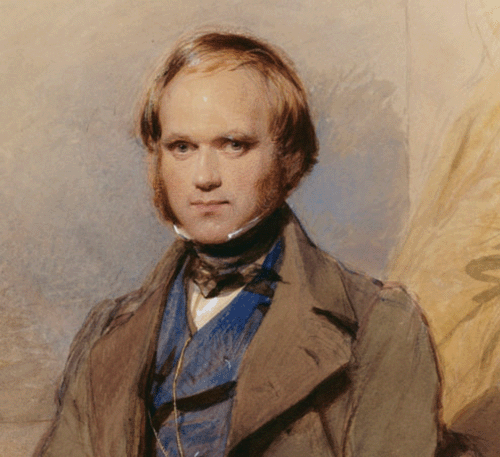
|
The beginnings
When Darwin left London in December 1831 as Naturalist on the voyage of the Beagle, who would have predicted that 28 years later he would publish a book (Origin of Species) that would pave the way for a new branch of science, called evolutionary biology? Who would also have predicted that almost 150 years later, Origin would be described as ‘one of the two or three most significant scientific works of all time – one of those works that fundamentally and permanently alter our vision of the world’ (Carroll 2003)?
It seems incredible now that Darwin’s father initially vetoed him going on the voyage, considering it a ‘wild scheme’ that ‘would be a useless undertaking’. Even more discouraging for the 22-year-old Charles, his father presumed that many others must have been offered the position of naturalist before his son, none had accepted, and thus ‘there must be some serious objection to the vessel or expedition’ (Allan 1977).
As a fresh graduate from Cambridge, what were Darwin’s credentials for being the Naturalist? Since his school days, he had been passionate about collecting things, especially birds and insects, he had studied some marine organisms while at Edinburgh University (finding it more interesting than his medical studies), studied botany each year at Cambridge in addition to his topics for a degree in theology, and had a few weeks experience as a field geologist in North Wales. Irrespective of these qualities, the man in charge of the Beagle, Captain Fitzroy, wanted ‘a man … more as a companion than a mere collector and would not take anyone however good a Naturalist who was not recommended to him likewise as a gentleman’ (Allan 1977). Far worse, Fitzroy initially had strong misgivings about Darwin’s ability to withstand the hardships of the voyage, based on nothing more than the captain’s knowledge of the physiognomy principles of the day and ‘the shape of Darwin’s nose’ (Allan 1977).
Fortunately, Charles was able to overcome his father’s objections to the voyage through the support of his uncle, Josiah Wedgewood. Captain Fitzroy also changed his views, and so Darwin joined the Beagle as Naturalist. The planned two-year voyage eventually lasted from December 1831 to October 1836. It saw Darwin circumnavigate the globe, mature as a naturalist and sowed the seeds of the ideas that were to become his theory of evolution presented in Origin of Species. The voyage also paved the way for the detailed botanical studies that Darwin subsequently carried out over four decades of his life, and that resulted in the publication of seven books and numerous scientific and popular articles on botanical topics.
At the start of the Beagle’s voyage, Darwin considered himself a geologist. Mention the Galapagos Islands that he visited during the trip, and most people associate him with the islands’ finches. But plants were an important component of Darwin’s observations and collections during the voyage. He was bowled over at his first experience of rainforest in Brazil, and returned from the voyage a changed man: ‘a traveller should be a botanist, for in all views plants form the chief embellishment. Group masses of naked rock, even in the wildest forms, and they may for a time afford a sublime spectacle, but they will soon grow monotonous. Paint them with bright and varied colours … they will become fantastic; clothe them with vegetation, they must form a decent, if not a beautiful picture’1.
This plant side of Charles Darwin is not well known. Yet he studied and published on topics including plant physiology, plant breeding and domestication, pollination biology, plant morphology and ecology. He studied embryos, seedlings and mature plants; roots, stems, leaves and flowers and modifications of them; and hundreds of species of flowering plants from different genera and families across the globe. The rise of plants to a time-consuming passion in his life, however, started from tenuous beginnings.
Plants and the voyage of the Beagle
During the voyage of the Beagle, Darwin spent as much time as possible on land, taking every opportunity for short excursions and longer field trips. As Naturalist, he collected specimens whenever he could and sent them back to John Henslow, Professor of Botany at Cambridge (who had recommended him as Naturalist for the voyage and who remained a life-long mentor and friend). Darwin’s botanical collections included flowering plants, ferns, fungi and lichens, and he sent both live seeds and dried herbarium specimens back to Henslow.
Early in the voyage, while on the east coast of South America, Darwin worried about whether he was collecting sufficient plant material (compared with his geological and zoological collections), and whether his dried specimens would be of any value. He was conscious of his lack of knowledge about plants and his lack of experience in collecting them and in July 1832, sent a letter to Henslow expressing these concerns. In July 1834, he received a response from Henslow, in a letter dated January 1834 (no quick communication then!) Henslow thought Darwin had ‘done wonders’ with the plants and gave him more instructions on collecting herbarium specimens: ‘avoid sending scraps. Make the specimens as perfect as you can, root, flowers and leaves and you can’t do wrong … a single label per month to those of the same place is enough except you have plenty of spare time or spare hands to write more’ (Allan 1977).
In addition to his collecting, Darwin kept a meticulous journal, taking ‘much pains in describing carefully and vividly’ all that he had seen (Carroll 2003), and would include material from it in letters to Henslow. Looking back on the voyage when he was 77 years old, Darwin noted in his autobiography that his most important activity during the voyage had actually been his ‘habit of energetic industry and of concentrated attention to whatever I was engaged in … Everything about which I thought or read was made to bear directly on what I had seen or was likely to see; and this habit of mine was continued during the five years of the voyage’ (Carroll 2003).
Arriving back in England in October 1836, Darwin was surprised to find that he returned with an established reputation as a naturalist. This was largely because while Darwin was away, Henslow had read some of his former pupil’s letters at meetings of the Philosophical Society of Cambridge, and had some printed for private distribution because of the interest they generated. Darwin also discovered that the botanical fraternity was far more interested in the botanical material he had sent back than the zoologists were in his zoological collections, and regretted not having spent more time collecting plants during the voyage.
In the seven years after his return, Darwin devoted his time to writing up and publishing material from his travels. It included five volumes on zoology (published 1840–43) and a volume on the structure and distribution of coral reefs (1842). First though, in 1839, he published as Volume III of the official record of the voyage his Journal and remarks (a second edition of which was published in 1845 as the better known book Journal of Researches into the Geology and Natural History of the Various Countries Visited by H.M.S. Beagle under the Command of Capt. Fitz Roy, R.N.). Despite the interest the botanists had shown in his plant collections, Darwin had not been able to get any of his plants identified before his journal was published – Henslow was too busy and to some extent out of his depth, and there were few other botanists that Darwin could call on to help. For this reason, the journal contained only a very general mention of plants; other aspects of natural history instead grabbed the readers’ attention.
Plants and the Origin of Species
After his return from the voyage, Darwin said he was haunted by ‘the supposition that species gradually became modified’ (Carroll 2003). He had arrived at this position through his observations particularly in South America and the Galapagos Islands. So, concurrent with writing up his journal and other volumes from the voyage, he was also ‘without any theory collecting facts on a wholesale scale’ (Carroll 2003). Over 1837–38, he devoured and kept notes on a wide range of scientific literature (including agriculture and horticulture) and non-scientific material, and corresponded and talked with many people, to collect facts that could throw any light on his ‘supposition’.
By 1839 he had formulated his ideas on the transmutation of species into a theory which he could test. He continued writing material from the voyage but commenced detailed botanical observations and experiments to gain more data and insight in relation to his theory. In June 1842, he allowed himself ‘the satisfaction of writing a very brief abstract of my theory in pencil in 35 pages; and this was enlarged during the summer of 1844 into one of 230 pages’ (Carroll 2003). The rest ‘is history’. On 1st July 1858, an abstract of Darwin’s manuscript and a letter to American botanist Asa Gray (dated 5 September 1857) outlining Darwin’s transmutation theory were presented to the public concurrently with an essay on speciation through variation and natural selection by naturalist Alfred Russel Wallace who had independently formulated the theory. So close were the theories that in the preceding month, Darwin wrote in a letter to a colleague that ‘if Wallace had my MS sketch written out in 1842, he could not have made a better short abstract!’ (Allan 1977). Darwin published an overview of his theory in the book Origin of Species 16 months later.
Plants that Darwin observed during the voyage of the Beagle had certainly contributed to his ideas about the transmutation of species. The ecology of plants interested him as much as obtaining specimens of them for herbarium or live seed collections. He observed changes in the distribution of plants with local topography, within different parts of the same country, and between countries. He recognised weedy plants from England, and wondered whether they had undergone any change when they became South American ‘residents’. He realised that the plants he collected from the Galapagos Islands differed from those of other countries he had been to as well as differing from island to island in the archipelago. He mulled over the role of geographic isolation in how species arose.
The major contribution of plants to his theory came, however, from his observations and experiments with plants at his home Down House, in Kent (Fig. 2), where he took up residence in September 1842. He used plants to construct hypotheses, which he then tested through experimental observations – in the adjacent meadows, in his garden, his greenhouse and hot house, and in his study and (when sick) his bedroom. Plants were easy to experiment with, provided quickly responsive material for experimentation, and were readily available either as part of the local flora or garden plants, or through his network of colleagues and friends around the globe. Plants enabled Darwin to complete and ground his ideas about the mechanisms of species’ evolution. His botanical observations and experiments continued for more than 20 years after Origin of Species was first published. He added new facts supporting his theory to successive editions of the Origin, so that the sixth edition published in 1872 had increased in size by a third from the first (1859) edition.
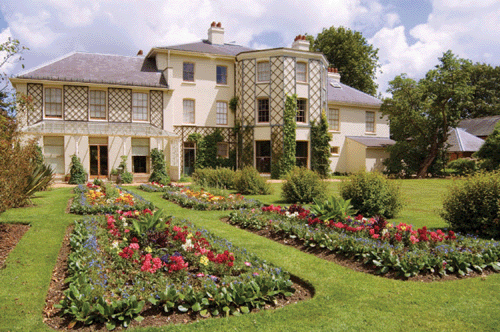
|
Darwin’s botanical books
Although by no means working exclusively on plants after publication of Origin of Species, between 1862 and 1880 Darwin published seven books solely or predominantly on plants. The research that underpinned them was always focussed on gaining more evidence to support the ‘laws of nature’ he had outlined in Origin, i.e. modification, the struggle for existence, survival of the fittest, and gradual evolution. He would become almost obsessed by the plants he was studying at any one time, captured by their beauty and intricacies, excited by the results of his experiments, and revelling in the challenge to either prove or disprove his own theories or those of others.
Darwin’s letters provide a glimpse of the pleasure he derived from plants:
-
to botanist Joseph Hooker, 12 July 1860: ‘I never saw anything so beautiful’ when marvelling at the mechanism for the transfer of pollen in Orchis pyramidalis2;
-
to geologist Charles Lyell, 24 November 1860: ‘… at this moment I care more about Drosera than the origin of all the species in the world’3;
-
to American botanist Asa Gray, 4 August 1863: ‘I have lots of Hobby-horses at present, fertility of peloric flowers and especially of ‘Homorphic’ seedlings, which I suspect will throw much theoretical light on Hybrids … But my present chief Hobby-horse I owe to you, viz tendrils; their irritability is beautiful, as beautiful in all its modifications as anything in orchids … Pray tell me whether anything has been published on this subject: I hate publishing what is old; but I shall hardly regret my work, if it is old, as it has much amused me’. And later in the same letter: ‘Depend on it, you are unjust on the merits of my beloved Drosera: it is a wonderful plant. I will stick up for Drosera to the day of my death’4; and
-
to colleague W. Thiselton-Dyer, 11 October 1877, when working on the movement of cotyledons as part of his experiments on ‘sleep plants’: ‘I am all on fire at the work’5.
And in his autobiography, Darwin stated ‘no little discovery of mine ever gave me so much pleasure as the making out the meaning of heterostyled flowers’6.
A brief look at Darwin’s botanical books gives a glimpse of the breadth and nature of his plant research.
Orchid pollination
During his wholesale collation of facts in 1837–38, Darwin had concluded that cross pollination was an important mechanism for keeping species ‘constant’, and had started studying insect-pollinated flowers. After publishing Origin of Species, he commenced detailed studies of orchids, such as Orchis mascula (Fig. 3), as they were ideal for examining the relationship between variation in flower structure and pollination by insects.
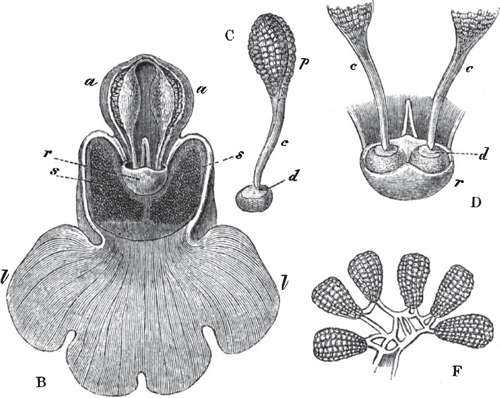
|
In the period from 1860 to early 1862, Darwin examined 15 genera of British orchids, two species of Australian orchid (Pterostylis trullifolia, now Diplodium trullifolium, and P. longifolia, now Oligochaetochilus longifolia), and 50 genera of exotic ornamental tropical orchids. He studied exactly how insects effected pollination, the function of different parts of the orchid flower in pollination, the nature of pollen grains, the production and location of nectar and how insects gained access to it. He would artificially irritate orchid flowers to simulate insect visits to find out exactly what triggered the movement of flower parts and resulted in the release of pollen.
Darwin published the results of his research in the book On the Various Contrivances by which British and Foreign Orchids are Fertilised by Insects in May 1862 (Darwin 1862). In it he described the numerous adaptations in basic flower structure that ensured each orchid species was cross pollinated by a specific insect, and explained the differences in flower structure by gradual evolution from a remote parent form. Despite misgivings about what his scientific colleagues would think, he wrote the book in a semi-popular style to make the information more widely accessible. He felt his approach was vindicated by the extremely positive views of his colleagues. For example, in December 1862 Joseph Hooker said, in a letter to a friend: ‘Darwin still works away at his experiments and his theory, and startles us by the surprising discoveries he now makes in Botany; his work on fertilisation is quite unique – there is nothing in the whole range of Botanical Literature to compare with it’ (Allan 1977). The book eventually ran to two editions and seven impressions, and remained a model writing style for his subsequent books.
Climbing plants
Darwin first started working on climbing plants after reading an article written by Asa Gray on tendrils. While growing seedlings of Echinocystis lobata, in the family Curcurbitaceae, he noticed the stem between the two uppermost leaves constantly and slowly twisted in a circular motion, unwound, then twisted in the opposite direction. The movement was independent of light, and continued during the day and into the evening. After talking with colleagues, he realised no one had yet explained how twining plants actually twined.
He examined over a hundred different sorts of climbing plants with a range of climbing mechanisms, including twining stems, leaf midribs (e.g. Nepenthes; Fig. 4) and tendrils. He studied the rate and direction of movement, variation in movement with plant age and variation in movement rates between different species. He would try to stop the circular motion of internodes by tying that section of the stem to a support and then observe what happened. He painted black lines and coloured streaks on the surface of stems to understand their movement, and was able to disprove the current view that stems twisted by spiralling around their axis. He tested the effect of light on the movement of tendrils, their response to different types of substrates (e.g. smooth bark, rough bark, wool, moss), and their response to touch.
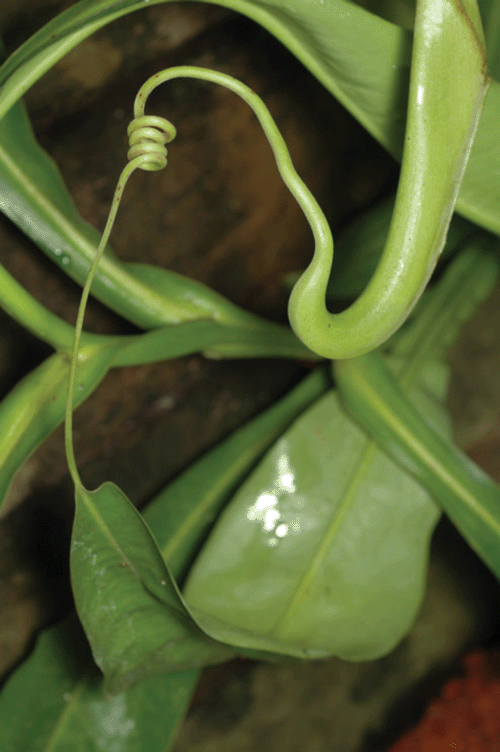
|
From his experiments and observations, Darwin was able to show that internodes, tendrils, leaf tips and leaf stalks all exhibited constant spontaneous movement. He concluded this movement allowed climbing plants to ‘find’ support. He discovered that tendrils could be modified leaves, modified flower stalks or modified branches. Darwin looked at other climbing mechanisms (e.g. hooks on roses, rootlets on ivy) but found that leaf climbers and tendril bearers were more common. He concluded that plants which climbed by modified leaves or by tendrils were ‘primordially twiners’ (Allan 1977), but had not remained twiners as the modified organs better enabled them to survive.
In his book On the Movements and Habits of Climbing Plants, published in 1865 (Darwin 1865), Darwin used twining plants to demonstrate his laws on modification and the struggle for existence, and included this evidence in the 4th edition of Origin of Species, published the following year.
Variation in domestic plants
From his voyage on the Beagle, Darwin knew that the food indigenous peoples ate looked very different to the food he was familiar with, for example, comparing stringy roots with carrots. He realised that the principles of domestication were important for his Origin of Species theory, and thought that by choosing particular types of plants to eat over many generations, humans had inadvertently carried out ‘an experiment on a gigantic scale’ (Allan 1977). While the parent form of many cultivated plants was known at the time by gardeners and horticulturists, Darwin was puzzled that many parent forms were unknown. He thought this could be the result either of the parents having become extinct, or of the plants having become significantly modified in cultivation.
Darwin started to study domesticated varieties of vegetables, fruit and ornamental garden plants (Fig. 5) to see if he could determine their parent form (whether from a single species, or hybrids) and understand how they had been bred. He examined as many varieties as he could lay hands on – 54 varieties of gooseberry and 41 varieties of common garden pea, for example. He grew seedlings, examining their variation in size, growth rates and possible reversion to wild types. He was particularly interested in abnormal flowers and instances of where cultivated plants reverted to their wild forms or one or both of hybrid parents.
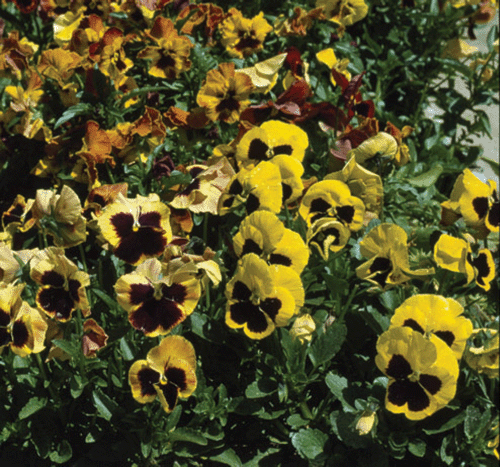
|
The results of Darwin’s work on both domestic plants and animals were published in 1868 in the book The Variation of Animals and Plants under Domestication (Darwin 1868). In it, he demonstrated that the explosion of horticultural plant types was based on small natural variations that had been selected and propagated by people. Darwin understood that humans could not ‘create’ variation. In the Introduction to his book he stated: ‘It is an error to speak of man ‘tampering with nature’ and causing variability. If organic beings had not possessed an inherent tendency to vary, man could have done nothing. He unintentionally exposes his … plants to various conditions of life, and variability supervenes, which he cannot even prevent or check’7.
During his studies, Darwin had realised that the embryos and seedlings of very different domestic plants often resembled each other, and probably resembled their common ancestor. In volume 2 of the book, he talked of organisms containing invisible characters related to ancestors over hundreds or thousands of generations and said ‘these characters, like those written on paper with invisible ink, lie ready to be evolved whenever the organisation is disturbed by certain known or unknown conditions’8. Darwin theorised that variation was inherited through ‘granules’ called ‘gemmules’ which are thrown off by cells, transmitted from parents to offspring, ‘and are generally developed in the generation which immediately succeeds, but are often transmitted in a dormant state during many generations and are then developed’9. Although his mechanism for characters to be transmitted is now known to be wrong, ‘in his conception of ‘gemmules’ being the carriers of inheritance [Darwin] was not so distant from the twentieth century conception of a gene’ (Professor John Heslop-Harrison, cited in Allan 1977).
Insectivorous plants
Darwin had started experimenting with sundews in the summer of 1860, although he did not start writing up his notes until late in 1872 after he had completed proofing his latest book The Expression of the Emotions in Man and Animals. For his first detailed work, he used Drosera rotundifolia, a species common in the meadows around his home Down House to understand the way in which insects were captured by the ‘tentacles’ on the leaves, and the mechanisms that underpinned it. He examined the proportion and speed of tentacles reacting, their recovery times, and how these changed with leaf age. He added things – live insects; dead insects; saliva; solution of any salt of ammonia; bits of hard boiled egg – to various parts of the leaf and observed how the tentacles and leaf responded. He examined how the glandular secretions were affected by adding substances such as sugar to leaves or immersing leaves in salty or acidic fluids. He studied tentacles under his microscope to see what happened at a cellular level and observed changes in the protoplasm as tentacles bent.
Darwin continued his experiments on other types of insectivorous plants. They included Drosophyllum lusitanicam whose leaves and stems are covered in stalked glands, the Venus Fly Trap (Dionaea muscipula) whose leaf parts snap shut when stimulated by an insect (Fig. 6), and the bladderwort (Utricularia neglecta), an aquatic plant that traps insects in ‘spring-loaded’ bladders held below the water surface.
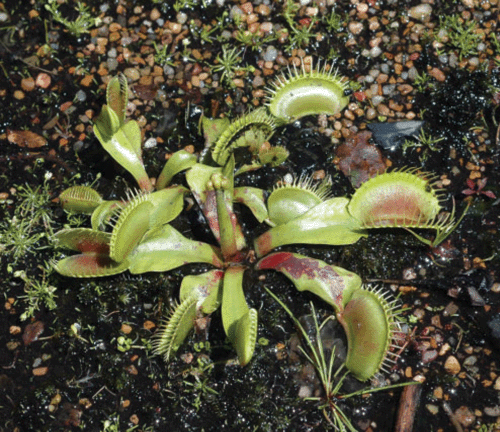
|
In 1875, Darwin published his book Insectivorous Plants (Darwin 1875), replacing and expanding on what had until then been unconnected, curious facts and for the first time presenting a comprehensive picture of how insectivorous plants ‘worked’. He described their ‘trapping’ mechanisms, including bending hairs, sticky fluids, closing leaves and bending leaf margins. Although it had previously been know that the glandular secretions of these plants acted as a trap and gastric juice, Darwin also showed the secretions had antiseptic properties that prevented trapped insects from rotting. Overall, he concluded that insectivorous plants all provided further evidence for natural variation, the struggle for existence and survival of the fittest.
Cross- and self-fertilisation
During his intensive fact finding in 1837, and knowing that flowers contain male and female parts, Darwin had wondered whether one plant received any influence from another. His orchid work (1860–62) had shown the range of mechanisms that ensured their flowers were cross-fertilised. Later, when doing experiments in 1866–67 for his Variation book, he had been astonished to find that the offspring of self-pollinated flowers of the Common Toadflax (Linaria vulgaris) and Wild Carnation (Dianthus caryophyllus) were much less vigorous than the offspring from cross-pollinated flowers.
Darwin eventually spent around 11 years doing thousands of experiments on a wide range of plant species to determine the benefit of cross-pollination. He prevented insects pollinating his flowers by covering the plants with nets, and carefully hand-pollinated flowers within and between plants of the same species, between plants of related but different species, and from species in very different families that were native to different countries. For each species, he would harvest the seed from his crosses, grow the offspring from selfed and crossed flowers in opposite sides of pots under identical conditions, monitor the growth rates and size of each type of seedling, and repeat the experiment when the seedlings matured and flowered. Some species he bred for 10 generations to see what would happen. As he compiled data from these experiments, he also spent more time understanding the mechanisms for ensuring cross-fertilisation, in flowers as disparate as Yucca (pollinated by a moth), Digitalis (pollinated by bees) and Arum (pollinated by midges).
Darwin’s work showed that plants arising from cross-fertilisation were usually far more vigorous than those resulting from self-fertilisation. He found that crossed plants always maintained their variation in flower colour. In contrast, he discovered in species such as Wild Carnation, Morning Glory (Ipomoea purpurea; Fig. 7), Blotched Monkey Flower (Mimulus luteus) and Petunia violacea that flower colour could be fixed by six successive generations of self-pollination. He concluded that it was a general rule of nature that most flowers were adapted to be crossed by pollen from a different plant from the same species.
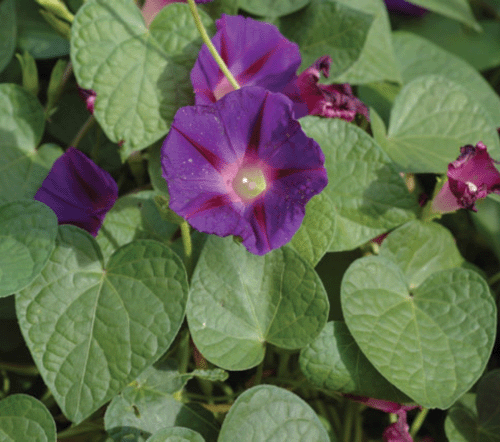
|
Darwin published the results in his book The Effects of Cross- and Self-fertilisation in the Vegetable Kingdom in 1876 (Darwin 1876). In the Introduction, he stressed that his most important conclusion had been that ‘the mere act of crossing by itself does no good. The good depends on the individuals which are crossed differing slightly in constitution, owing to their progenitors having been subjected during several generations to slightly different conditions, or to what we call in our ignorance spontaneous variation’10.
The results of his work on crossing for the first time provided those in the horticulture and florist industries with scientifically based tools for their work. Shortly after Darwin’s book was published, the Gardeners’ Chronicle hailed it as ‘a perfect mine of facts’, noting that much that had been ‘mere haphazard and of a tentative nature’ in the practices of seed growers and hybridisers ‘has been by Mr Darwin reduced to rule and method’ (Allan 1977).
Different forms of flowers: heterostyly
People in Darwin’s time were aware that the cowslip (Primula vulgaris) had two types of flowers, one in which the anthers were held well above the stigma, the other in which the stigma was held above the anthers. Darwin was the first to record that the two forms always appeared on different plants and that each form was constant on its own plant. Describing these flowers as ‘dimorphic’, Darwin wanted to know the reason for their differences, and started growing the plants. He prevented insects visiting the flowers, to establish they were needed for pollination, then hand-pollinated them with all combinations of stamen length and stigma height.
Darwin went on to study other dimorphic plants – more species of Primula, three species of Linum (L. flavum, L. grandiflorum and L. perenne) – and the trimorphic Purple Loosestrife (Lythrum salicaria; Fig. 8). From his artificial pollination experiments, he found that of the four options for pollination in dimorphic flowers, only two would produce fertile offspring, while for the 18 pollination options in trimorphic flowers, only six would result in fertile offspring. In his sixth edition of Origin of Species (published in 1872), Darwin summarised his findings: ‘in order to obtain full fertility with these plants, it is necessary that the stigma of the one form should be fertilised by pollen taken from the stamens of corresponding height in another form’11.
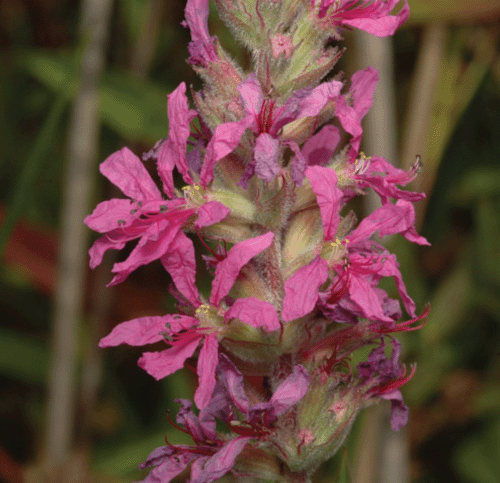
|
Darwin concluded that heterostyly was another mechanism to ensure cross-fertilisation, and that such fertilisation could also be achieved by incompatible pollen, the pollen and stigma maturing at different times on the one flower, and by the male and female organs occurring on different plants. He published the detailed results of his studies in 1877 in his book The Different Forms of Flowers on Plants of the Same Species (Darwin 1877). While his results provided further support for Origin of Species, the understanding of the pollination mechanisms was of enormous practical value to plant breeders, especially those breeding fruit trees, as it ‘enabled hybridisers to work their plants successfully and avoid sterility’ (Allan 1977).
Power of movement
After publishing Different Forms of Flowers, Darwin re-commenced experiments on plant movement. According to his theory of evolution, climbing plants (the subject of his second botanical book) could only have evolved if all kinds of plants ‘possessed some slight power of movement of an analogous kind’ (Allan 1977). He set out to test this, experimenting with plants across the flowering plant kingdom, including annuals, perennials, conifers, bulbous plants and aquatic plants.
He started with the movement of seedling radicles then examined that of hypocotyls before working with the mature stems of plants. He made observations day and night, and used simple household items to measure the direction and speed of movement or carry out experiments to try to prevent it. He studied how the movement varied with age and compared the speed of movement between different species. He looked at specific types of movement – leaves ‘sleeping’ at night time, for example the leaves of white clover, Trifolium repens (Fig. 9), the downward movement of fruit capsules (for example in species of Cyclamen) and movement towards even the dimmest light (using for example Phalaris canariensis).
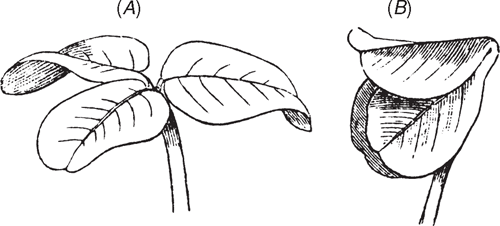
|
In his book The Power of Movement in Plants (Darwin 1880), published in 1880 when he was 74 years old, Darwin demonstrated for the first time and explained the circling movement (which he called ‘circumnutation’) of seed stems, mature stems and leaves. He demonstrated that seed radicles circumnutated but also responded to gravity. He found that plants which closed at night needed some direct light during the day to do so, and worked out that the ‘sleep’ movement was related to changes in the degree of hydration of the pulvinus. He demonstrated that the downward movement of Cyclamen capsules was not caused by gravity but by movement away from light (apheliotropism), and was able to demonstrate that this and movement towards light (heliotropism) were both extensions of circumnutation. He also demonstrated, in the cotyledons of Phalaris, that the effects of light were transmitted, apparently by ‘the presence of some matter in the upper part which is acted on by light, and which transmits its effects to the lower part’12. The ‘matter’ – growth hormones – was discovered ~50 years later.
Ingredients of Darwin’s success
During Darwin’s lifetime and since his death in April 1882, many have pondered why he was so successful as a scientist. After the publication of Darwin’s orchid book in 1862, Joseph Hooker had said Darwin’s ‘powers of observation, memory and judgement seem prodigious, his industry indefatigable and his sagacity in planning experiments, fertility of resources and care in conducting them are unrivalled’ (Allan 1977).
In his autobiography written between 1876 and 1881, Darwin reflected on the success of his career (Carroll 2003; Darwin 1887). He acknowledged he had ‘no great quickness of apprehension or wit’ and therefore was ‘a poor critic’, that his ‘power to follow a long and purely abstract train of thought’ was very limited, and that his memory was ‘extensive, yet hazy’. Despite the views of some of his critics, he considered he had good ‘power of reasoning’ as the ‘Origin of Species is one long argument from the beginning to the end, and it has convinced not a few able men’. He also thought he had a ‘fair share of invention, and of common sense or judgement’ although not ‘in any higher degree’. He concluded ‘my success as a man of science … has been determined, as far as I can judge, by complex and diversified mental qualities and conditions. Of these, the most important have been – the love of science – unbounded patience in long reflecting over any subject – industry in observing and collecting facts – and a fair share of invention as well as of common-sense. With such moderate abilities as I possess, it is truly surprising that I should have influenced to a considerable extent the belief of scientific men on some important points.’
Upon Darwin’s death, Thomas Huxley talked of Darwin’s ‘intense and almost passionate honesty by which all his thoughts were irradiated, as by a central fire’ and noted that it was this that ‘kept his vivid imagination and great speculative powers within due bounds; which compelled him to undertake the prodigious labours of original investigation and of reading, upon which his published works were based; which led him to allow neither himself nor others to be deceived by phrases, and to spare neither time nor pains in order to obtain clear and distinct ideas upon every topic with which he occupied himself’ (Allan 1977).
Almost 130 years later, Carroll (2003) attributed Darwin’s success to his ‘inventive fertility and self-critical rigour’, his ‘caution and circumspection, his ambition, objectivity, and patient determination’, and his ‘courage, audacity, and sustained constructive energy … placed under the command of a characteristic that seems rather quiet, mild, and modest’. He judged that ‘Darwin could succeed as an independent and original thinker of the first magnitude because he encompassed within his own method and character all the necessary phases or aspects of generating and testing hypotheses that are normally distributed throughout the scientific community and that constitute a long-range institutional process’.
Conclusion
Few scientists today have the independent financial status that enabled Darwin to be a full time scientist without the need for paid employment. The simple household items that he used for his experiments would no longer be sufficient, having been replaced by complex and frequently expensive scientific equipment. Yet many of the attributes of Darwin are relevant for the aspiring graduate of the early 21st century: curiosity, a desire to understand ‘why’ and ‘how’, strong powers of observation, inventive experimentation, patience, sustained focus, clear reasoning, and independent thought to name but a few. Of course, a natural history trip around the world might also be helpful, but need not take five years.
Acknowledgements
Much of the material in this article has been drawn from Allan (1977) and to a lesser extent from the introduction and two appendices in Carroll (2003).
1 http://darwin-online.org.uk/content/frameset?viewtype=text&itemID=F10.3&pageseq=1 (page 604) [Verified 28 April 2009].
2 http://darwin-qa.caret.cam.ac.uk/darwinletters/calendar/entry-2864.html [Verified 25 April 2009].
3 http://www.darwinproject.ac.uk/darwinletters/calendar/entry-2996.html [Verified 24 April 2009].
4 http://www.darwinproject.ac.uk/darwinletters/calendar/entry-4262.html [Verified 28 April 2009].
5 http://www.archive.org/stream/morelettersofcha02740gut/2mlcd10.txt (letter 743) [Verified 28 April 2009].
6 http://charles-darwin.classic-literature.co.uk/the-autobiography-of-charles-darwin/ebook-page-25.asp [Verified 25 April 2009].
7 http://darwin-online.org.uk/content/frameset?itemID=F877.1&viewtype=text&pageseq=1 (page 2) [Verified 28 April 2009].
8 http://darwin-online.org.uk/content/frameset?itemID=F877.2&viewtype=text&pageseq=1 (page 36) [Verified 28 April 2009].
9 http://darwin-online.org.uk/content/frameset?itemID=F877.2&viewtype=text&pageseq=1 (page 374) [Verified 28 April 2009].
10 http://darwin-online.org.uk/content/frameset?itemID=F1249&viewtype=text&pageseq=1 (page 27) [Verified 28 April 2009].
11 http://darwin-online.org.uk/content/frameset?itemID=F391&viewtype=text&pageseq=1 (page 253) [Verified 28 April 2009].
12 http://darwin-online.org.uk/content/frameset?itemID=F1325&viewtype=text&pageseq=1 (page 486) [Verified 28 April 2009].


